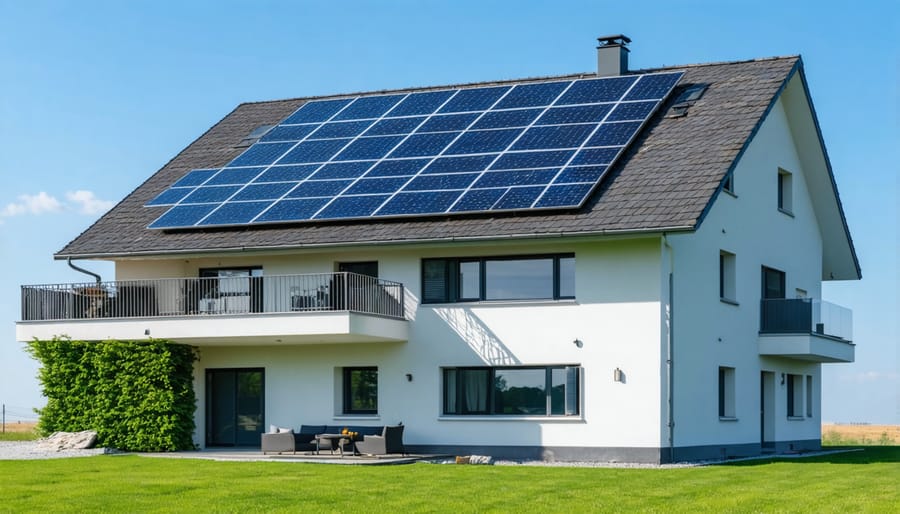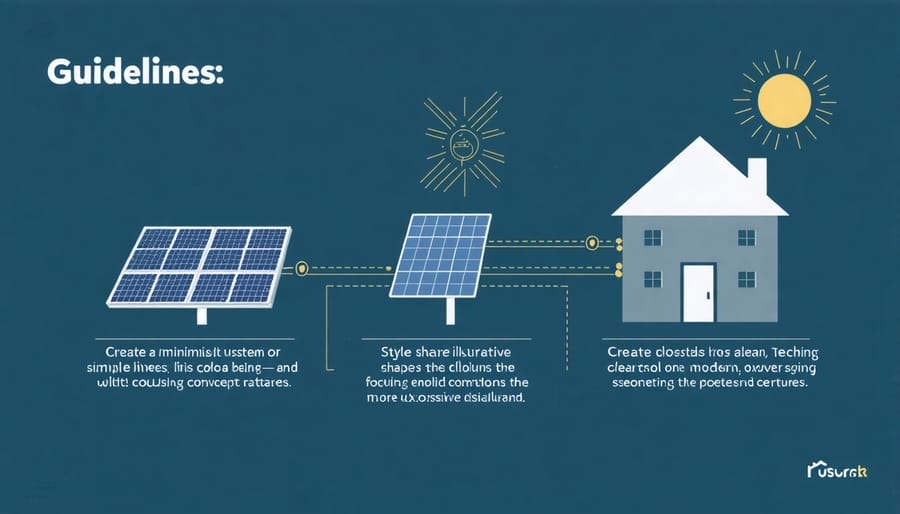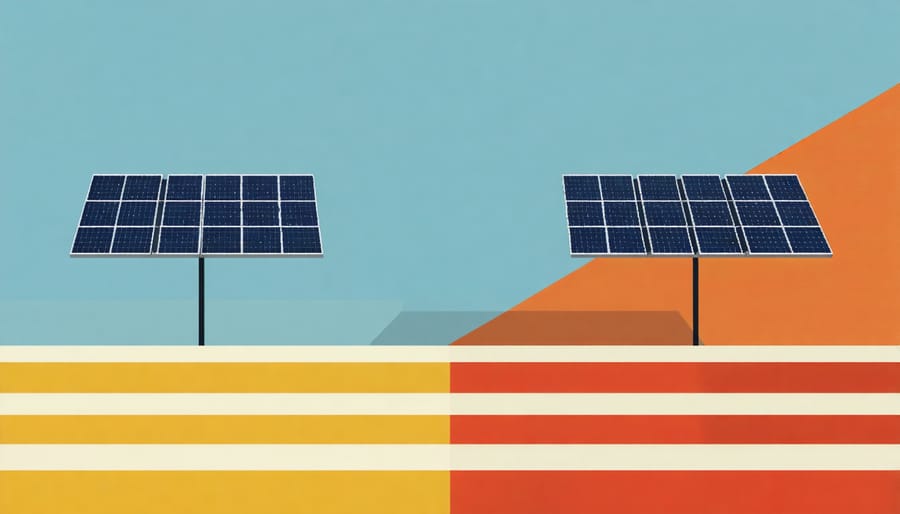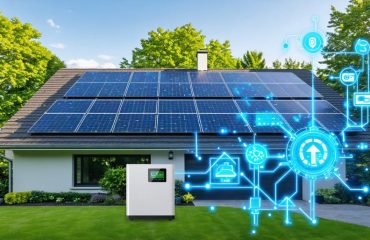Imagine powering your entire home without ever receiving another electricity bill. Solar energy independence represents more than just installing panels on your roof – it’s a transformative shift toward complete energy autonomy that puts you in control of your power generation and consumption. As utility costs continue to rise and grid reliability becomes increasingly uncertain, homeowners across America are discovering that solar independence offers a practical, sustainable solution for long-term energy security.
Modern solar technology has made it possible to break free from traditional power companies while potentially earning money through excess energy production. With battery storage systems becoming more affordable and efficient, complete energy independence is now within reach for many households. The combination of falling installation costs, generous tax incentives, and improved technology has created an unprecedented opportunity for homeowners to achieve true energy self-sufficiency.
This comprehensive guide will walk you through everything you need to know about achieving solar energy independence – from initial assessment and system design to installation and optimization. Whether you’re motivated by environmental concerns, rising energy costs, or the desire for energy security, understanding the path to solar independence is your first step toward a more sustainable and financially sound future.
What True Energy Independence Means for Homeowners

Breaking Free from the Grid
Solar panels offer a transformative path to energy independence, fundamentally changing how homeowners interact with traditional power utilities. By generating your own clean electricity, you can significantly reduce or completely eliminate your reliance on the grid. Modern microgrid systems allow you to store excess energy in batteries for use during nighttime or cloudy days, ensuring continuous power supply.
The shift toward solar independence happens gradually. Many homeowners start with a grid-tied system, using solar power as their primary energy source while maintaining grid connection as backup. As your system generates electricity, you’ll see immediate reductions in your utility bills. In many cases, excess power can be sold back to the grid through net metering programs, turning your home into a mini power station.
With advanced battery storage solutions, you can achieve complete energy autonomy. This independence protects you from power outages, rising utility costs, and grid reliability issues. Plus, you’ll have the satisfaction of knowing your home runs on clean, renewable energy that you generate yourself.
Protection Against Rising Energy Costs
Installing solar panels acts as a powerful shield against ever-rising utility rates, offering homeowners predictable energy costs for decades to come. While traditional electricity rates typically increase by 2-3% annually, solar system owners can effectively lock in their energy costs at today’s rates, creating a reliable financial forecast for their household expenses.
Think of solar panels as a hedge against future rate hikes. Once installed, your system generates electricity at a fixed cost, regardless of what happens to market energy prices. This protection becomes increasingly valuable as utility companies continue to raise their rates due to infrastructure upgrades, fuel costs, and regulatory changes.
Many homeowners see immediate monthly savings after switching to solar, but the real financial advantage compounds over time. As utility rates climb year after year, solar users maintain steady energy costs, potentially saving tens of thousands of dollars over their system’s lifetime. This cost predictability also helps with long-term financial planning, allowing households to budget more effectively and invest their savings in other important areas.
Essential Components of a Solar Independence System

Solar Panel Arrays
Achieving solar energy independence starts with properly sizing your panel array to meet your household’s energy needs. The average American home requires between 20-24 solar panels to cover its full electricity usage, though this varies based on factors like local climate, roof orientation, and energy consumption patterns. To determine your specific needs, review your past year’s utility bills and calculate your daily energy usage in kilowatt-hours (kWh).
Modern residential solar panel installation typically uses 400-watt panels, meaning a 20-panel system can generate up to 8,000 watts under ideal conditions. Consider adding 20-30% extra capacity to account for reduced efficiency on cloudy days and to ensure surplus power for storage. South-facing roof installations offer optimal sun exposure, but east and west-facing arrays can still provide sufficient power with additional panels.
For complete independence, factor in seasonal variations and include a battery storage system to maintain power during nighttime and low-light periods. Your local solar installer can help calculate the exact number of panels needed based on your specific circumstances and energy goals.
Energy Storage Solutions
Energy storage is the key to achieving true solar independence. Modern home battery storage solutions allow you to capture excess solar power during sunny days and use it when the sun isn’t shining. These systems typically consist of lithium-ion batteries that seamlessly integrate with your solar setup, providing reliable backup power during nighttime, cloudy days, or grid outages.
Most residential battery systems can power essential appliances for 24-48 hours, depending on your energy usage and battery capacity. Popular options like the Tesla Powerwall or LG Chem RESU can be easily mounted on walls or placed in garages, taking up minimal space while providing maximum energy security.
Smart battery systems automatically detect power outages and switch to stored energy within milliseconds, ensuring uninterrupted power to your home. They also help you maximize savings by storing excess solar energy instead of sending it back to the grid, and some systems can even help you avoid peak utility rates by drawing from stored power during high-cost periods.
Backup Power Integration
While solar panels provide reliable daytime power, backup generators play a crucial role in achieving complete energy independence. These systems automatically kick in during extended periods of low solar production or unexpected outages, ensuring your home stays powered 24/7. Modern backup generators can be seamlessly integrated with your solar setup through smart controllers, creating a robust hybrid system that maximizes reliability. Natural gas or propane generators are popular choices, offering clean-burning operation and extended run times. For ultimate peace of mind, consider a generator sized to power essential circuits like refrigeration, heating, and security systems. This combination of solar and backup power creates a truly resilient home energy system that works in all conditions.
The Path to Solar Independence
Energy Usage Assessment
Before installing a solar energy system, understanding your household’s energy consumption is crucial. Start by reviewing your past 12 months of electricity bills to identify your average monthly usage in kilowatt-hours (kWh). Pay special attention to seasonal variations, as your energy needs likely fluctuate between summer and winter months.
Consider conducting a home energy audit to identify potential efficiency improvements. Simple changes like LED lighting, improved insulation, or energy-efficient appliances can significantly reduce your overall energy needs before sizing your solar system.
Track your daily energy patterns by noting when you use the most electricity. Are you typically home during peak sunlight hours? Do you run major appliances at night? This information helps determine if you’ll need battery storage or might benefit from adjusting your usage patterns.
Don’t forget to account for future changes, such as adding an electric vehicle or home additions. A properly sized solar system should accommodate both current needs and anticipated increases in consumption over the next 5-10 years.
System Design and Planning
Designing the right solar system for your home begins with a thorough assessment of your energy needs. Start by reviewing your past 12 months of electricity bills to understand your average daily consumption. This baseline helps determine the size and number of solar panels needed for complete energy independence.
Most residential solar systems aimed at independence require between 6kW to 12kW of capacity, depending on household size and energy usage patterns. Factor in seasonal variations – you’ll need enough panels to meet your winter needs when sunlight is less abundant. Consider future changes too, such as adding an electric vehicle or home additions.
A comprehensive system typically includes solar panels, inverters, and battery storage. The battery component is crucial for true independence, allowing you to store excess energy for nighttime use or cloudy days. Many homeowners opt for a battery capacity that can support 2-3 days of typical usage.
Your roof’s size, orientation, and angle play vital roles in system design. South-facing roofs in the Northern Hemisphere typically offer optimal sunlight exposure. If roof space is limited, high-efficiency panels can help maximize power generation in a smaller area.
Working with a qualified solar installer will ensure your system meets local building codes and utility requirements while achieving your independence goals. They can also help determine if additional features like microinverters or power optimizers would benefit your specific situation.
Installation and Integration
The journey to solar energy independence typically begins with a professional site assessment to evaluate your home’s solar potential and energy needs. This initial consultation usually takes 1-2 weeks, during which experts analyze your roof orientation, shading, and structural integrity.
Once you’ve approved the system design, permit acquisition follows, generally lasting 2-4 weeks. During this time, your solar provider handles all necessary paperwork and local regulations. The actual installation process is surprisingly quick, usually completed in 1-3 days for residential systems.
Professional installers will mount the solar panels, connect the inverter system, and install necessary safety equipment. They’ll also set up monitoring systems that allow you to track your energy production through user-friendly mobile apps or web interfaces.
The final step involves utility company inspection and meter installation, typically taking 1-2 weeks. All told, most homeowners can expect the entire process—from initial consultation to system activation—to take 6-8 weeks. Your installer will guide you through each phase, ensuring a smooth transition to solar independence.
Financial Benefits of Solar Independence
Long-term Energy Cost Savings
When calculating long-term energy savings from solar panels, most homeowners see a return on their investment within 5-10 years, followed by significant savings for decades to come. The average American household can save between $10,000 and $30,000 over a 20-year period, depending on local electricity rates and sunlight exposure.
Consider this: solar panels typically have a lifespan of 25-30 years, with manufacturers guaranteeing at least 80% efficiency even after 25 years. If your monthly electric bill averages $150, you could potentially save $45,000 or more over your system’s lifetime, accounting for rising energy costs.
These calculations become even more favorable when you factor in:
– Annual electricity rate increases (historically 2-3% per year)
– Federal tax incentives (30% of system cost)
– State and local rebates
– Increased home value (average 4.1% boost)
– Protection against utility rate fluctuations
Keep in mind that maintenance costs are minimal, typically requiring only occasional cleaning and basic system checks. Modern solar panels are highly durable and rarely need repairs, making your long-term savings even more predictable.
For maximum financial benefit, consider installing your system while incentives are at their peak, as these programs often decrease over time. The sooner you switch to solar, the greater your lifetime savings potential becomes.

Available Incentives and Tax Benefits
The federal government currently offers a substantial 30% tax credit through the Investment Tax Credit (ITC) program for residential solar installations, making the switch to solar power more affordable than ever. This credit applies to both the equipment and installation costs, potentially saving homeowners thousands of dollars on their solar investment.
Many states offer additional incentives that can stack with federal benefits. These may include state tax credits, property tax exemptions, and sales tax exemptions on solar equipment purchases. Some states also provide performance-based incentives, paying homeowners for the solar energy they produce.
Local utilities often supplement these programs with their own incentives, such as net metering programs that credit homeowners for excess energy sent back to the grid. Some utilities also offer rebates or grants for new solar installations, which can significantly reduce upfront costs.
Special financing options are available through various programs, including PACE (Property Assessed Clean Energy) financing and solar-specific loans with competitive interest rates. Many solar installers also partner with financial institutions to offer zero-down payment options and flexible payment plans.
Remember that incentives can change annually, so it’s wise to check current offerings when planning your solar installation. Working with a qualified solar installer can help ensure you maximize all available benefits and incentives in your area.
Embracing solar energy independence represents more than just a shift in how we power our homes – it’s an investment in our future and our planet. By transitioning to solar power, homeowners can take control of their energy destiny while contributing to a cleaner, more sustainable world. The benefits are clear: substantial savings on monthly utility bills, protection against rising energy costs, increased property value, and a significantly reduced carbon footprint.
The path to solar independence is more accessible than ever, with improved technology, declining installation costs, and numerous financial incentives making the switch both practical and affordable. Modern solar systems are reliable, require minimal maintenance, and can provide decades of clean, renewable energy for your home.
Whether you’re motivated by environmental concerns, financial savings, or the desire for energy security, solar independence offers a compelling solution. The time to act is now – with current federal tax incentives, state rebates, and financing options, there’s never been a better opportunity to invest in solar energy.
Take the first step today by researching local solar installers, exploring available incentives, and calculating your potential savings. Your journey toward energy independence not only benefits your household but also helps create a more sustainable future for generations to come. Join the growing community of solar-powered homes and become part of the clean energy revolution.









